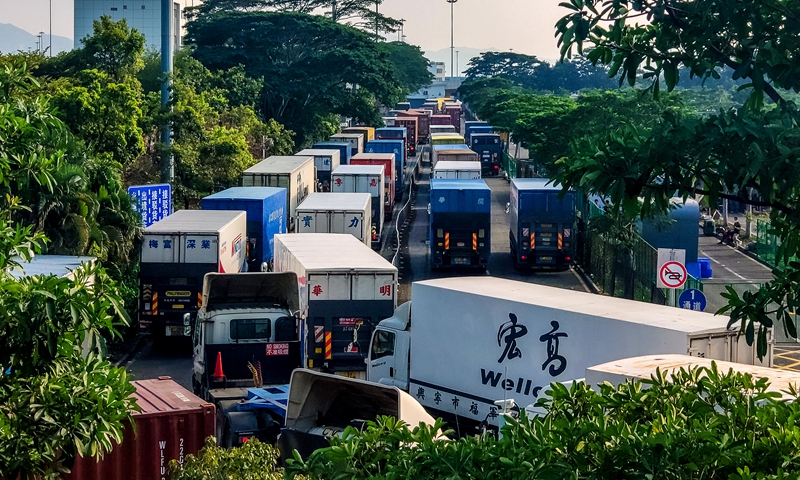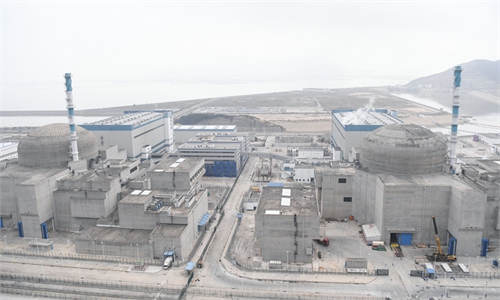China’s economic powerhouses post slower GDP growth, prompting calls for more aggressive policies

Trucks exit Shenzhen Bay Port on February 14, 2022 in Shenzhen, South China's Guangdong Province. Photo: VCG
A new round of COVID-19 flare-ups continues to add pressure to the Chinese economy, with two major economic powerhouses - Shanghai and South China's Guangdong Province - recording GDP growth rates below the national level of 4.8 percent during the first quarter of 2022 due to interruptions caused by lockdowns, while northern and inland provinces' economies surged ahead on the back of stable investment and consumption.
The disparity in local GDPs reflects mounting economic pressure from demand contraction, supply shocks and weakening expectations amid multiple COVID-19 resurgences and a complicated and grim external environment, economists said, as they called for more aggressive macro-economic policies, including cash handouts, to stabilize growth.
During the first quarter, Guangdong's GDP reached 2.85 trillion yuan ($438 billion), up 3.3 percent year-on-year, 1.5 percentage points lower than the national average of 4.8 percent growth, according to data released by local government.
Meanwhile, Shanghai, which has been shocked by an abrupt spike in cases starting in March, reported GDP growth of 3.1 percent to 1 trillion yuan.
Growing external uncertainties brought about by the Russia-Ukraine conflict, and COVID-19 resurgences in Shanghai and Guangdong further dampened consumers' expectations, disrupted industry and supply chains, and affected local imports and exports, Mao Yanhua, dean of the Institute of Regional Openness and Cooperation of Sun Yat-sen University, told the Global Times on Sunday.
"Some export-oriented manufacturers in coastal areas are reluctant to accept foreign orders, as profits are severely squeezed due to inflated international bulk commodity prices and shipping costs," he said, adding that intra-provincial logistics bottlenecks in some areas also affected manufacturing.
By contrast, many provinces in middle and western areas such as Central China's Hubei and Hunan provinces, Southwest China's Guizhou Province and North China's Shanxi Province led national growth with GDP growth rates all above 6 percent.
Cao Heping, an economist from Peking University, told the Global Times on Sunday that middle and western cities that are empowered by the digital economy, for example Wuhan in Hubei and Xi'an in Northwest China's Shaanxi Province, will continue to record sound performances for the rest of the year.
However, one of the problems faced by the economy as a whole is weakening expectations, as the short-term impact of the COVID-19 has become a long-term one, Cao said, noting the recovery of consumers' expectations will need three to five years. "Compared with coupons, the handout of cash to residents will directly stimulate consumption and therefore help stabilize expectations," he said.
Cong Yi, professor of the Tianjin University of Finance and Economics, told the Global Times on Sunday that accelerating the establishment of a unified domestic market will be of crucial importance for China's economy to offset the shock of the pandemic, as it will help smooth the running of elements and give full play to the advantage of the super large domestic market to boost "dual circulation."
Given mounting downward pressure in the second quarter, "we need to effectively put the outbreak under control, especially in the first 10 days of May," Wang Yiming, a member of the monetary policy committee of the Chinese central bank, said at a forum held in Beijing on Sunday, according to media reports.
Wang called for more aggressive macroeconomic policies to cushion the impact of COVID-19 flare-ups and drive second-quarter GDP growth above 5 percent, building a sound foundation for achieving the annual target of 5.5 percent growth.
China's growth "remains in positive territory," IMF Managing Director Kristalina Georgieva told a virtual press conference during the 2022 Spring Meetings of the IMF and the World Bank held on Wednesday. "We see China capable of boosting the economy, because it has ample policy space," she said, the Xinhua News Agency reported.
On Friday, the People's Bank of China, the country's central bank, held a meeting to assess the current economic and financial situation, vowing to ramp up support for the real economy, according to a statement on its website.
It pledged to continue a prudent monetary policy to maintain reasonable and ample liquidity, and to reduce overall financing cost. Meanwhile, it will greatly support agricultural production and the production and supply of crucial energy sources like coal and gas to maintain stable commodity prices, while implementing financial policies to stabilize enterprises and protect jobs, especially small and micro-sized businesses and industries and groups vulnerable to the epidemic.



